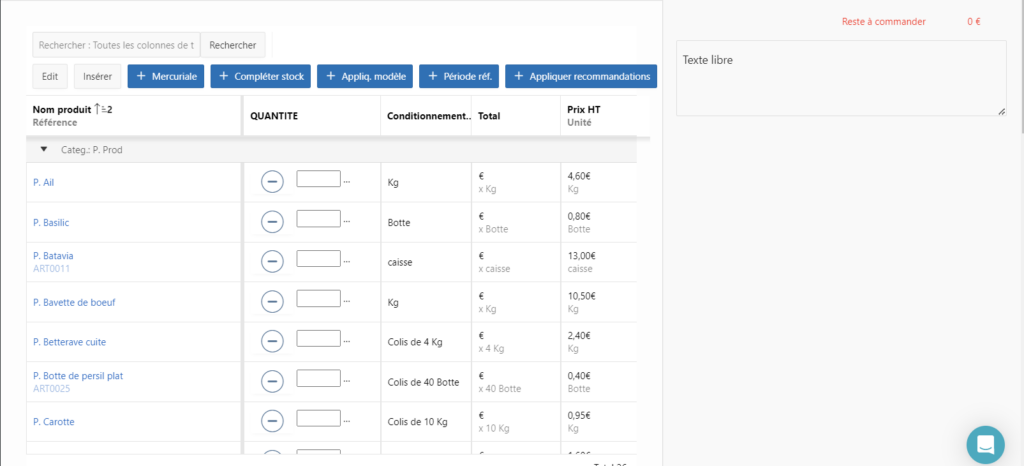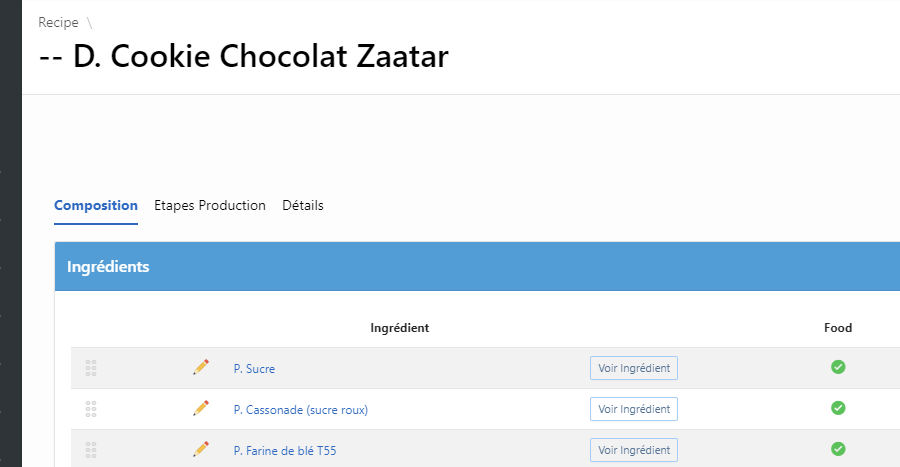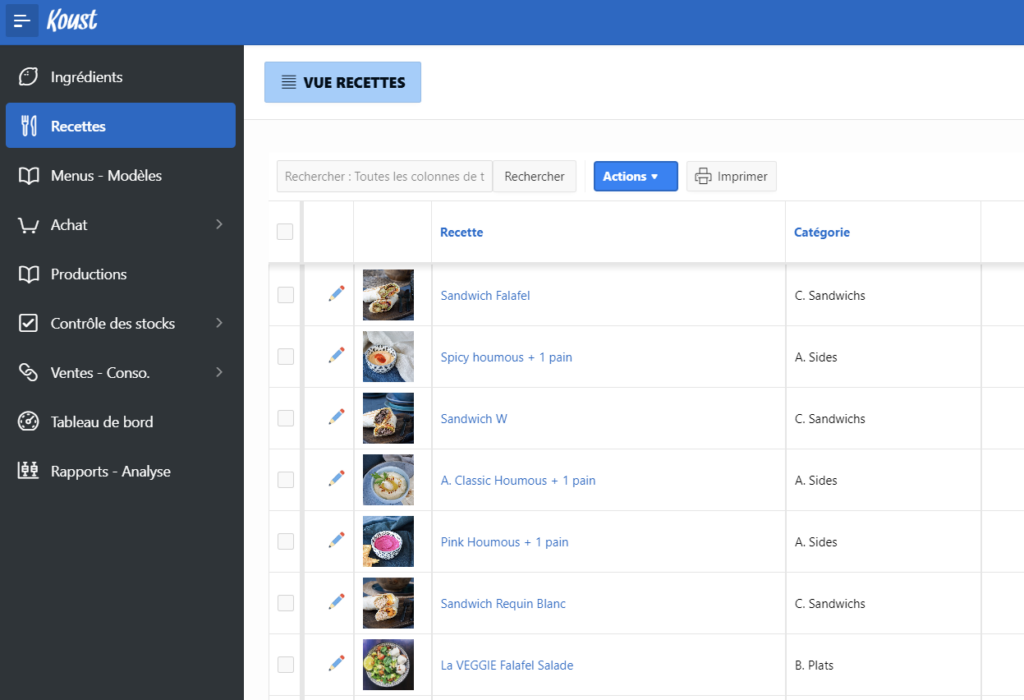I have been using the Koust solution for several years now, which is roughly Inpulse's competing solution (more AI-focused, even if Koust seems to be catching up on this aspect), and as many restaurateur colleagues ask me how I manage stocks between the different establishments for which I work, this article in the form of a “crash test” will constitute a sort of answer.
Here is basically the different features of Koust, with a focus on those that I use the most, and at the end the advantages, which I will quickly go over because the functionalities speak for themselves and are in essence the advantages of Koust, and the limits, on which I I will expand further because if the solution is currently very satisfactory, it would greatly benefit from being improved.
2) Basic functionality: placing your supplier orders
Originally, many restaurants used choco to order from their supplier. Where Choco was very strong was that they initially positioned themselves as a simple ordering tool that simplified the lives of restaurants and their suppliers, thus avoiding the telephone and long paper lists, to ultimately pivot like an Amazon of suppliers and wholesalers, moving away from internal inventory management.
This is where a solution like Koust – or Inpulse for that matter – can make life easier for restaurateurs. The initial idea is to enter your references (ingredients, raw materials, drinks, etc.), and your suppliers.

Once this is done, all you have to do is place your orders, which will automatically be sent by email to your suppliers. You will then know in the WEB version of Koust if the supplier has opened your order, in order to be reassured that it has been properly taken into account.
Once the orders have been received, Koust allows you, through its mobile application or directly on its WEB version on a computer, to confirm receipt of the order, and above all to validate the quantities of the goods received. In the event of an error, Koust sends a notification to the supplier with the creation of a credit note.
This is for the overall aspect of this functionality, to which is added a whole bunch of very practical options for restaurateurs (mercurials, printing of the order form, etc.) and which I will not detail here because it would take too long.
2) Real-time inventory tracking
The second functionality which results from the first is that by receiving your food, you as a manager know the quantities currently stored within your establishment.
You can therefore monitor stock levels in real time, receive notifications for replenishments and manage orders from your suppliers. This allows you to minimize stock shortages, optimize your orders and control your costs, thus contributing to better profitability for your restaurant.
In practice, how does Koust know that there have been exits? On simple purchase-resale products, such as drinks for example, Koust will know how many drinks you have sold in connecting to your POS software and by generating your Z in the evening, Koust will update the current stock. Thus, by carrying out regular inventories, you will be able to compare the actual observed with the purely theoretical stock calculated by Koust, and thus pinpoint certain discrepancies.
To know the output of transformed materials, it will first be necessary to create recipes from the ingredients previously entered, which brings me to the 3rd functionality.
3) Creation of recipe sheets and calculation of cost prices
Koust allows you to save and organize all the information related to their recipes, including ingredients, quantities, costs and preparation steps. Thus, thanks to the solution, you have access to the cost price of each of your recipes, provided that you have entered the correct purchase prices.
This is a huge step forward for restaurateurs who can more precisely estimate the expenses linked to each dish, control margins and adjust prices accordingly. Additionally, by centralizing recipe data, Koust makes it easier to update information, track variations in ingredient costs, and make informed decisions to maximize the establishment's profitability.

So, as with the drinks example, if you have a poke bowl recipe that uses 90g of salmon, and 150g of rice, and after 2 days, you realize that Koust estimates your stock beyond the actually observed stock of salmon and rice, you will be able to act so that the cooks have a little less heavy hand during service, or possibly reassess the selling price in order to respect your margins.
4) The dashboard
The dashboard is a page in the Koust dashboard allowing restaurateurs to view the key monthly statistics of their establishment, such as turnover, gross margin and value of purchases, thus allowing them to monitor and analyze the financial performance of their restaurant.
5) Managing supplier invoices
Another practical feature of Koust is the management of supplier invoices. This tool in Koust allows you to manage supplier invoices, to find out whether they have been paid or not, and to export all of this to accounting.
This tool allows you to help manage your cash flow and manage late payments.
6) The inter-establishment tool
The functionality that I am very fond of is inter-establishment management. Koust makes it possible to pass one of the chosen establishments, for which it will therefore be necessary to pay a special subscription, as a supplier establishment to the other establishments. This is particularly practical for restaurant chains, whose lab produces for their stores.
In practice, every day, points of sale generate an order from their lab, and this lab therefore has a global production sheet, which it will be able to execute via a printable PDF.
Each recipe can be declared as “completed”, which allows Koust to continue to calculate current stocks based on the processing of goods, previously entered ingredient stocks, and recipe sheets correctly configured and respected by the staff. of the kitchen.
Finally, Koust allows you to produce recipe cards for cooks, with the desired quantity of products to prepare.
Once production is ready, the transporter will deliver to the points of sale, and this materializes in Koust as a real purchase order between the lab and the subsidiaries, which will have to be validated on the subsidiary side to increase the “sale”.
7) Hygiene, calories and many more features
Koust provides other useful features such as everything related to hygiene, traceability but also labels indicating the number of calories and macronutrients for each product, or even Menu engineering, in its intermediate version. And for the most motivated, there is a more expensive “business” version, including forecasting via artificial intelligence, which I have not personally tested.
The rates
Prices range from €960/year for the entry-level version, up to €2,160/year for the business version, and an intermediate version exists at €1,560/year. Here you will find the complete summary table of packages and features, to choose the one that best suits your needs.
The “inter-establishment” option is an additional paid extension, just like the “hygiene” option.
The advantages of Koust
For the moment, this is the solution that I continue to use, proof of which is that I am generally satisfied with it. Once the solution is adapted, it is very difficult to imagine how we could work without it.
Furthermore, it is not a solution launched by a start-up boosted by fundraising and whose sole aim is to be bought out, but rather by a team of enthusiasts, starting with its founder, a former restaurateur with professional experience.
The solution also provides a help center, with plenty of videos and tutorials to get you started.
Finally, the solution is super complete, and the teams are super responsive to answer questions, whether by email or chat.
The limits of Koust
The main limitation of Koust is its propensity to want to cover all possible and imaginable functionalities. And by dint of chasing all the hares at once, the solution sometimes tends more towards the gas factory than towards the dreamed 360° solution.
Then, let's be honest, the user experience is very... outdated, and often quite slow when loading. The graphics are dated to say the least, and the number of inconsistencies are legion, especially on the mobile application, which is not very practical. For example, to change establishment, you will have to make several accidental clicks (no less than 4 actions!), and not just one, as is the case on any multi-account dashboard.
Another major flaw, in the age of mobility, is that it will be almost impossible for you to manage your inter-establishment transfers on the mobile web version (this functionality is not available on the app), because the ordering pages that are supposed to be responsive are completely unreadable. You will therefore always need to have a computer with you, even on vacation…
Then, there were quite a few bugs that we often reported, which gave us the impression more of being beta testers than customers, without any commercial gesture from the sales team.
Another problem is the lack of notifications, whether by email or on the mobile app. When you run out of stock on certain sensitive products, or when a supplier has not opened your order, it would be wise to send a reminder to managers.
Yet another problem is the accidental disconnection of your session. Basically, you will have to connect to EVERY launch of Koust, whether on the app or on the web, which is, in today's web, nonsense. Worse still, it is impossible to open 2 tabs at the same time to check information on another establishment with a mouse click, for example, while placing an order. This automatically disconnects you or switches you to the other establishment without you realizing it…
The inventory is also a source of errors, because when you generate one, and you want to correct a value, it is completely impossible for you to do so, except to make a subtraction, which again, from a point of operational view, is ubiquitous to say the least.
The real stock/theoretical stock gap that I spoke about previously is also difficult to understand, especially in terms of the choice of dates to be made, and must probably lose a good part of the users who have not done advanced math.
Taking a photo of purchase orders or invoices on the mobile app side is also totally crazy, a quick look at any message or dating application would be enough to know how to properly integrate a functionality from a user experience point of view. camera” in a mobile app.
The list of foods is also displayed in order of last modification, and it is completely impossible to display ingredients and recipes in predefined order, for example based on categories or simply in alphabetical order, in order to display the most relevant in first for example, or to search for a particular ingredient at first glance in alphabetical order without going through the search bar.
Finally, the pricing is like the solution: super complicated, quite expensive to the point that we get completely lost and are often incapable, as a restaurant, of knowing which solution would suit us.
Finally, it is the parts “placing an order”, “developing a recipe” and therefore logically “cost of a recipe” which are the best done and therefore the simplest to use. For the rest, there is still a lot to do in terms of pedagogy and fluidity.
Koust would benefit from a sort of “shock of simplification” as the other would say, both in terms of user experience and in terms of price, by proposing for example 3 simple prices, and a much more “UX” solution. " compatible.
In short, the solution is certainly very complete, but the pitfall for the restaurateur consists of paying for a very expensive tool, only to ultimately use only 5% of the solution, because it lacks simplicity.
However, for experienced brands that have staff dedicated to inventory management, this tool can constitute a real gold mine, both in terms of optimizing margins and in terms of order tracking. But for a beginner, the solution can quickly become a long, somewhat incomprehensible and expensive obstacle course.
Conclusion
Koust is a powerful tool for restaurant management, offering advanced features to simplify your daily operations, and there is no doubt that with a little design and fluidity, a little AI for order management, and an app more ergonomic mobile, the tool will be the ultimate solution for restaurateurs.
